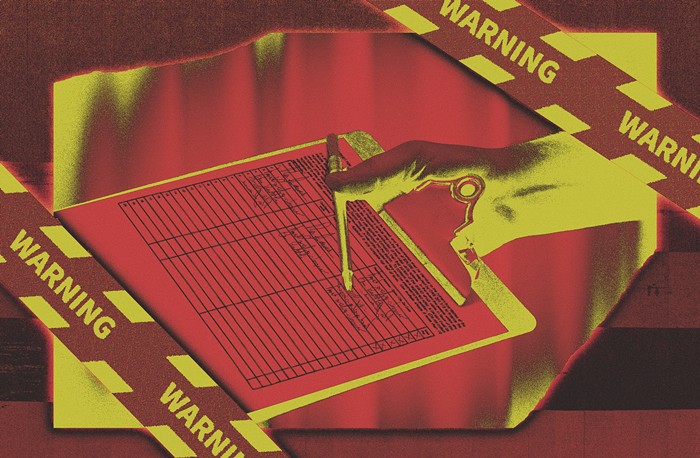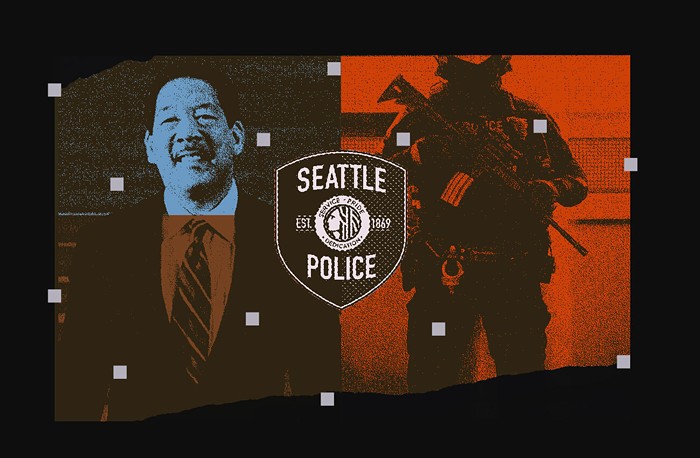
After nearly two years of being underground, and after more than a year of being stuck, the world's largest tunnel-boring machine took a major first step toward being repaired yesterday: A 270-ton piece of Bertha's shield was lifted out of the ground. Three more pieces of the giant machine's front end will need to follow as repairs on Bertha officially begin.
To say that reporters were expecting a symbolic moment yesterday is an understatement. Physically, Bertha has been immobilized beneath Seattle, but spiritually, the $80 million machine has been boring into the psyches of everyone living above her: Mayor Ed Murray, for one, who sponsored a 2009 law to pay for the tunnel project; city council members, who had interrogated or defended the project for months; WSDOT; Seattle Tunnel Partners (STP); the Seattle Department of Transportation; Seattle Public Utilities; Pioneer Square residents, who have been monitoring their buildings for cracks; state senate Republicans, who refuse to spend any more money to fix the problem; urban planners and transit fans, who railed against the machine when it was still just an idea; the global tunneling community; anyone who tuned in to America's most famous car infrastructure boondoggle; anyone who got sick of hearing the word "boondoggle."
Through doing absolutely nothing, Bertha had become famous, a celebrity wreck.
The media advisory went out at 6:11 a.m. By the time I arrived to the work-site around 9 a.m., some reporters had already been on top of a truck bed platform in full view of the edge of the hole for more than an hour. WSDOT spokesperson Laura Newborn looked down at her phone and announced 9:30 a.m. would be the tentative start of the lift.
9:20 a.m: Gulls landed on work site lights next to the Alaskan Way Viaduct, the double-decker elevated highway erected in 1953 that Bertha's tunnel is supposed to replace. The viaduct's expiration date started getting closer in 2001, when it began sinking after the Nisqually earthquake. In 2007, a University of Washington study gave the structure four years to shut down. In 2009, WSDOT released an animation video of what another serious earthquake might do to certain sections of the structure, which sort of resembled what might happen if you dropped a phone book onto a table next to a pyramid of sugar packets.

10 a.m: The piece still hadn't been lifted; meanwhile, traffic thundered over the viaduct. Workers in neon vests outside the pit swept and welded while reporters on the truck bed milled around and made small talk. In February, four workers were injured after falling 25 feet when a wall collapsed. In early March, the Associated Press found that more workers had filed injury claims in the year Bertha was stuck than they did in the two previous years she was moving.
Noon: The piece still hadn't been lifted, and Newborn got word that it would be a while. We could go grab something to eat; she would e-mail us before the start.
2 p.m: Newborn summoned reporters to the platform. Half an hour later, a crawler crane started slowly pulling up a rusty piece of the shield shaped like an enormous frown.
Bertha's part hung there on steel cables, exposed. It started to rain.

"It took a little longer than expected, but we wanted to make sure we were all set to do it right, to do it safely," STP's Chris Dixon told reporters nearly an hour later, after the piece had been towed to the side and settled on timber. He explained that the biggest, one-of-a-kind lifting effort would likely arrive in more than a week, when a giant crane would raise another part of Bertha—the 2,000-ton cutterhead and drive unit—from the pit. From there, the timeline of repairs would stretch through the summer.
Still no word about what caused the initial breakdown in December of 2013, but all that will eventually become public, Dixon said.

STP has said that Bertha is set to restart tunneling in August, when it will still have to chew through 8,000 feet of earth beneath Seattle. If the rest of the tunnel project repairs are completed on time, Dixon has said that the tunnel will open to traffic in 2017, nearly two years behind schedule.


















